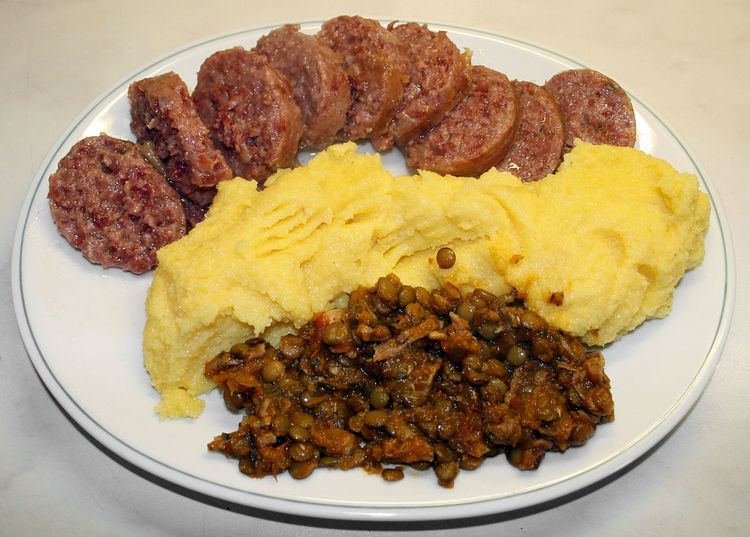 | ||
Polenta ([poˈlɛnta]) is a dish of boiled cornmeal that was historically made from other grains. It may be served as a hot porridge, or it may be allowed to cool and solidify into a loaf that can be baked, fried, or grilled. The dish is associated with Northern and Central Italy.
Contents
Description
Polenta has a creamy texture due to the gelatinization of starch in the grain. However, its consistency may not be completely homogeneous if a coarse grind or hard grain such as flint corn is used. The variety of cereal used is usually yellow maize, but buckwheat, white maize, or mixtures thereof may be used. Coarse grinds make a firm, coarse polenta; finer grinds make a creamy, soft polenta. Polenta is a staple of Northern Italian cuisine (and, to a lesser extent, a Central Italian one, e.g. Tuscany) and its consumption is traditionally associated with lower classes, as in times past cornmeal mush was an essential food in their everyday nutrition.
As it is known today, polenta derives from earlier forms of grain mush (known as puls or pulmentum in Latin that were commonly eaten since Roman times. Before the introduction of corn (maize) from America in the 16th century, polenta was made from starchy ingredients like farro (wheat), chestnut flour, millet, spelt (wheat), and chickpeas. Historically, polenta was served as a peasant food in North America and Europe. The reliance on maize as a staple, which lacks readily accessible niacin unless cooked with alkali to release it, caused outbreaks of pellagra throughout the American South and much of Europe until the 20th century. In the 1940s and 1950s, polenta was often eaten with salted anchovy or herring, sometimes topped with sauces.
Etymology
Latin polenta covered any hulled and crushed grain, especially barley-meal, and is derived from the Latin pollen for "fine flour", which shares a root with pulvis, meaning "dust".
Preparation
Polenta is typically simmered in a water-based liquid with other ingredients. Later, once the polenta is done, ingredients can also be added. It is often cooked in a large copper pot, known as a paiolo in Italian. Boiled polenta may be eaten as is, or it may be allowed to set and then baked, grilled or fried. Leftovers can be used the same way. Cooked polenta can be shaped into balls, patties, or sticks, and then fried in oil, baked, or grilled until golden brown; fried polenta is called crostini di polenta or polenta fritta.
Cooking time
Polenta takes a long time to cook, simmering in four to five times its volume of watery liquid for about 45 minutes with near-constant stirring, necessary for even gelatinization of the starch. Some alternative cooking techniques have been invented to speed up the process, or to not require constant supervision. Quick-cooking (pre-cooked, instant) polenta is widely used and is prepared in just a few minutes; it is considered inferior to polenta made from unprocessed cornmeal and is best eaten after being baked or fried.
In his book Heat, Bill Buford talks about his experiences as a line cook in Mario Batali's Italian restaurant Babbo. Buford details the differences in taste between instant polenta and slow-cooked polenta, and describes a method of preparation that takes up to three hours, but does not require constant stirring: "polenta, for most of its cooking, is left unattended.... If you don't have to stir it all the time, you can cook it for hours—what does it matter, as long as you're nearby?" Cook's Illustrated magazine has described a method using a microwave oven that reduces cooking time to 12 minutes and requires only a single stirring. In March 2010, it presented a stovetop, near-stir-less method that uses a pinch of baking soda (an alkali), which replicates the traditional effect. Kyle Phillips suggested making it in a polenta maker or in a slow cooker.
Italian variations
In the Trieste area of northeastern Italy, it is eaten either with cuttlefish and tomato broth (the Venetian tradition), with sausage (Austrian influenced), or with cooked plums (an ancient recipe).. Polenta can also be prepared with porcini mushrooms, rapini, or other vegetables or meats, such as small songbirds (in the case of the Venetian and Lombard dish polenta e osei).
Some Lombard polenta dishes are polenta taragna (which includes buckwheat flour), polenta uncia, polenta concia, polenta e gorgonzola, and missultin e polenta—all are cooked with various cheeses and butter, except missultin e polenta, which is cooked with fish from Lake Como In some areas of the Veneto region, it can also be made from white cornmeal (mais biancoperla, once called polenta bianca). In some areas of Piedmont in the northwest, it can also be made from potatoes instead of cornmeal. In the westernmost alpine region, the maize is sometimes combined with local grains like barley and rye (polente bâtarde or polente barbare), and often frichâ, and toasted on a loza (thin refractory stone).
